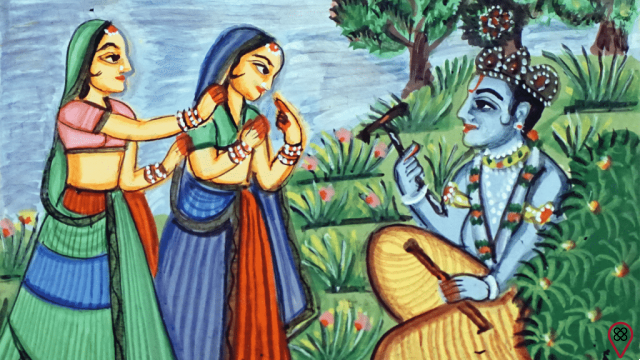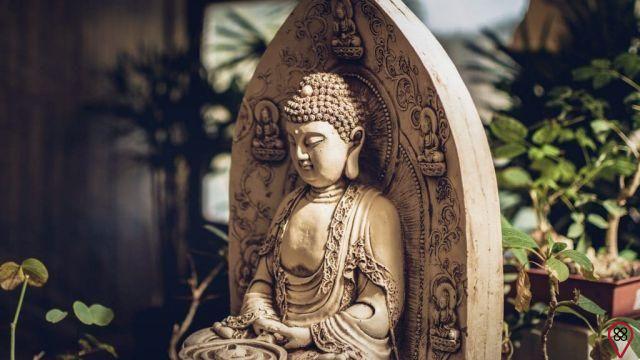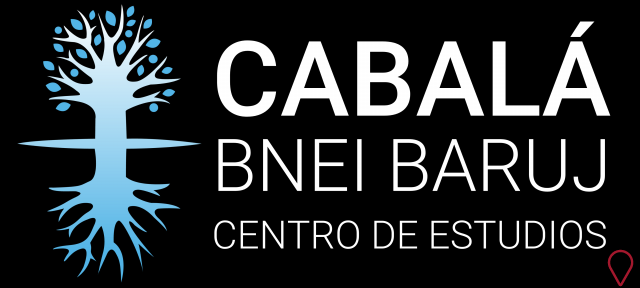You've probably heard about Buddhism and many of the things it preaches, but there are certainly doubts. Even more so because, because it is not part of our western culture, there can be a lot of misinformation about this religion. By the way, is Buddhism really a religion?
Currently with more than 500 million followers worldwide, and increasingly present in Western culture, Buddhism is a religion that emerged in India approximately 2,5 years ago. His philosophy brings teachings that can be applied to any other religion — or even to those who don't follow any.
And with all this popularity — including here in España, which has almost 250 supporters — it is not uncommon for several doubts to arise on the subject. If you are very interested in what Buddhism has to teach, what it means and its origins, follow the article to clear all your doubts once and for all!
What is Buddhism?
Well, for starters, Buddhism is a religious and philosophical doctrine that is based on the teachings left by Shakyamuni Buddha (born Siddartha Gautama). It is a non-theistic religion — that is, it does not support the idea of the existence of one or more gods.
The term “Buddha” has its origins in Sanskrit and its meaning is “the one who has become enlightened”. “Sakyamuni” is related to the Sakya clan, one of the four lineages of Buddhism (the other three are Gelug, Kagyu and Nyingma).
The origin of Buddhism dates back to the time when the young prince Siddartha lived in his palace, surrounded by riches and ostentation, isolated from royal life, which was completely different from what he led. Upon leaving the palace and colliding with the reality of extreme poverty and suffering, the young man decided to abandon his luxuries and isolate himself, so that he could find a way to end people's suffering.
Separated from mundane life, Siddartha resolved to become a disciple of asceticism—a doctrine that completely denies the desires and pleasures of life and that includes the practice of physical penance and rigorous fasting.
However, after years of practicing asceticism, the young man ended up not identifying with the path of this philosophy, as it was not making his consciousness progress. The enlightenment, the answers he sought… nothing came of it. Therefore, he abandoned the path of suffering, because he concluded that it would not bring mental and emotional balance. And balance is the basis of self-knowledge.
One day, Siddartha finally found the answers to what ailed him, and at the age of 35, he managed to achieve a full understanding of the essence of life—the famous act of enlightenment. Hence the name “Buddha”, whose meaning we have already explained above.
From then on, Buddha began to preach his message throughout India, for more than four decades, transmitting his first teachings: the Four Noble Truths. But we'll talk about that later on.
How did Buddhism spread?
After having spread across India, Buddhism then left the country, expanding throughout Asia. As we said at the very beginning, as it is a doctrine that is completely adaptable to any religion – and also culture –, this philosophy was easily established in the countries where it arrived. In Tibet, for example, it developed in such a peculiar way that we reserved an exclusive topic to deal with this topic.

Then it was time for Westerners to learn about Buddhist philosophy, but from a Tibetan perspective. The significant number of adherents today has made more and more people become interested in the teachings and beliefs of Buddhism.
What is the holy book of Buddhism?
The more than four decades (45 years, to be more precise) of the Buddha's preaching allowed him to give humanity 84 teachings—or dharmas. All of them were turned into sutras—rules for everyday life.
These sutras make up the set of sacred scriptures of Buddhism: the Tripitaka (with the variant “Tipitaka”), or Canon in Pali. The work was written in Sri Lanka, in the Pali language — a language of ancient India and very similar to the one spoken by the Buddha during his lifetime.
It is a vast literary collection divided into three parts, or "baskets" (hence its name - "Ti" means "three", and "pitakas", "baskets", in the language in question). These parts that form the Tripitaka are the holy books of Buddhism:
Vinaya Pitaka — a Discipline
This book contains a disciplinary code of the Order of monks and nuns. It also tells how these norms originated and gives a brief account of the Buddha's life and ministry.
Sutta Pitaka — the Discourses
It is a compilation of the speeches of the Buddha and his closest disciples over the 45 years he preached his doctrine.
Abhidhamma Pitaka — a Doctrine Absoluta
It elaborates on the previous book, reorganizing it in a more scientific way. It is a dense work, which brings an analysis of concepts that help in understanding the nature of mind and matter.
These works are a true outline of the teachings of Buddhism, but we will highlight, below, the most basic and well-known lessons of the doctrine, which can be applied in all situations of our lives.
You might also like:
- Zen Buddhism: Get to Know This Spiritual Philosophy Up Close
- Find out what is the main purpose of Buddhism
- Know the difference between exoteric and esoteric Buddhism
What are the teachings that Buddhism preaches?
The Buddha's preaching began with teachings arising from the personal experience he had based on what he lived with asceticism and the moment he ascended. Among these teachings are the Four Noble Truths:
- Life is suffering, disharmony and imbalance—the nature of suffering (dukka).
- Suffering is the fruit of the Three Mental Poisons (anger, greed and ignorance) — the origin/cause of suffering (samudaya).
- Equilibrium can be restored—the cessation of suffering (nirhodha).
- The Middle Way is what leads us to balance in life—the way that frees us from suffering (maggha).
The first of the Truths is there to remind us of the cyclical existence of sufferings and births, of the need to understand that suffering needs to be fully understood — it is awareness.
The second Noble Truth makes us aware that suffering is not a mere work of chance, it is not a punishment for our bad actions (it is not a god punishing us for our sins). Suffering is only the result of our attachment to desire, to our lack of satiety, to our ego. Not that pleasure is something to be condemned; what is problematic is that we have become his slaves.
The third of the Truths comes to reassure us about the possibility of ending suffering, with the end of insatiable desire, through facing our ignorance. In closing, the Fourth Noble Truth talks about the need to avoid the extremes of life: neither excessive pleasure nor total renunciation. It is called the Middle Way.
This path to putting an end to suffering is divided into eight parts (hence also called the Noble Eightfold Path): Right Understanding, Right Thought, Right Speech, Right Action, Right Livelihood, Right Effort, Right Watchfulness and Right Concentration.
In other words, everything, according to Buddhism, is a matter of balance, based on ethics, to achieve a full life. And that is what governs everything that involves the belief of Buddhists.
What do Buddhists believe?
Not being a religion centered on one or more deities, not even Buddha saw himself as a deity. He felt more like a spiritual guide.
Although Buddhism is a non-theistic religion, Buddhists believe that all beings incarnate and reincarnate—not just human beings. Therefore, they defend that goodness needs to be directed to every being, because we can reincarnate in any form.
Followers of the doctrine also believe in physical and spiritual consciousness as a path to fleeting and ultimate happiness (enlightenment). For them, the main purpose of consciousness is nirvana - the full physical and spiritual knowledge - which allows to end all suffering and lead to peace.
What are the symbols of Buddhism?
Buddhist symbols represent this spiritual path that leads to the ultimate inner peace of enlightenment. They were offered to the Buddha so that he would reciprocate by teaching about what he achieved when he became enlightened, that is, the wisdom that frees from suffering.
These symbols also represent protection, harmony, faith, inspiration, purity, detachment from illusion, wisdom and balance.
We highlight here the eight auspicious symbols and their meanings, for you to understand a little better about each one of them. Check out:
- Lotus flower — one of the most important symbols of Buddhism. The beautiful lotus flower emerges from the swamps, towering over the mud. The analogy is that, even under the adversities and toxicities of life, it is possible to keep the essence intact and dignified.
- pair of gold fish — originally a symbol of the sacred rivers Ganges and Yamuna, this figure represents abundance, fertility, prosperity and joy, as it moves freely.
- not infinity — its intertwining lines with no beginning or end represent eternal continuity, the idea that there will always be something after something else. Reincarnation is an example of this continuity. It also symbolizes cause and effect, being known as a symbol of karma.
- Dharma Wheel —its eight rays represent the eight teachings of the Buddha mentioned above in the Four Noble Truths. It symbolizes leading to freedom from suffering, promoted by Buddhist teachings.
- white shell — is the word of the Buddha, the sound of dharma awakening us from ignorance.
- Sunshade — symbolizes protection against suffering that can destabilize and bring us down.
- Jar — refers to the infinite knowledge of the Buddha and the generosity of his teachings. It can also represent health and long life.
- Victory flag — symbolizes the victory of positive thoughts over negative ones. It is also a symbol of the Buddha defeating the lord of illusions, who was always creating snares to prevent the Buddha from achieving enlightenment.
There are, of course, other meanings for these symbols, and they can be used in different ways, with the aim of rescuing in us the essence of each one's purpose and of Buddhism itself.
Who is the religious leader of Buddhism?
Speaking of symbologies and representations, we can include the figure of the Dalai Lama, who, in addition to being a religious leader, is like the personification of the teachings of Buddhism, given his responsibility to propagate the teachings of the doctrine.
If we make a superficial religious comparison, he would be like the Pope, not least because he is also a head of state, as well as the leader of the Catholic Church.
We say “superficial” because the Pope is chosen through election. In the case of the Dalai Lama, a search is made for his incarnation in a baby born a few years before the death of the one who will succeed.
It is valuable to understand the difference between the Buddha and the Dalai Lama. The first is a person who has woken up from the sleep of ignorance. The second is a title, granted to an individual of the Gelug lineage of Tibetan Buddhism. He represents the incarnation of the Buddha, but of a specific one—Avalokiteshvara, known as the Buddha of Compassion.
The term “dalai-lama” means “ocean of wisdom” in Mongolian. And the first title was bestowed in 1578, by a Mongolian prince, on the third incarnation of Avalokiteshvara, the Buddha of Compassion.
Today, the Dalai Lama is Tenzin Gyatso. In addition to the task of spreading Buddhism around the world, he also has the mission of propagating the Tibetan cause and culture, responsible for the development of the line of Buddhism that we know here, in western lands.
What is Tibetan Buddhism?
There are different Buddhist strands. The one that has a more ritualistic character than the one that gave rise to it is precisely the one that developed in Tibet. It is also known as Vajrayana Buddhism or Lamaism — the latter term referring to the figure of the Dalai Lama, who, as we said, is the spiritual leader of Buddhism.
When it spread beyond India, upon reaching Tibet, Buddhism underwent a series of modifications, associated with the shamanic beliefs typical of the region. Thus, Tibetan Buddhism ended up being influenced by ancient religions, such as bonpo, in addition to other spiritual traditions.
In this aspect, meditative practices are more refined, involving large ritualistic cults that include the reading of sadhanas — liturgical texts for the practice of Vajrayana meditation — in which there is visualization of meditational deities. In addition, mantras are chanted, with the use of bells, drums and other instruments.
This was the variation of Buddhism that spread predominantly in the West. However, for the East, there is no such thing as “Tibetan”, since there is no distinction between practices. And no such distinction really matters; what matters is that it is through Buddhism that we can achieve balance and our evolution as people.
As you can see, Buddhism has a number of contributions to your well-being, self-knowledge and improvement as a human being, through the practice and adaptation of the teachings it brings to the world, regardless of religion or belief. If you found this content interesting, please share it with your friends and family. Don't forget to check out other content we've prepared on the topic!

























